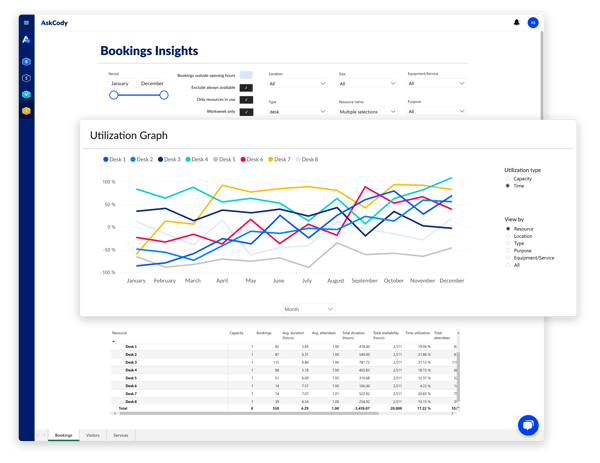It is no secret that the way we work is changing. Therefore office space utilization and efficiency is more important than ever. In the past, everyone worked from the office, every day. Today, nearly 70% of people work from home at least one day a week. From 2005 to 2017, there has been a 159% increase in remote work.
Other offices are switching to an ABW (activity based) model, which provides a mix of quiet workspaces, shared workstations, break-rooms, and conference rooms that allow workers to switch environments based on the type of work they are doing and how they work best.
Flexibility at work is important to workers, and that includes flexible workspaces. In fact, 82% of millennial workers said they would be more loyal to that employer, and 22% would be willing to work longer hours if they had more flexibility at work. But, these changes come with unintended consequences affecting efficient office space.
Office space utilization metrics
Despite increased loyalty and productivity, flexible working arrangements can cost big when space utilization is not considered. A recent survey found that 40% of workspaces are underutilized — and it is costing businesses big.
What is office space efficiency?
Office Space efficiency is about optimizing the use of office space, reduce unused square feet while getting the most out of your available real estate. Many adjustments to the office layout is created based on gut feelings and biased opinions, therefore workplace analytics and insights are crucial to understanding office behavior and making the required workspace adaptions to increase office space efficiency.
Why Does Space Utilization Matter So Much?
How much does it really matter much if your office has a few extra desks or a few underused meeting spaces? Let's look at the numbers.
What is the 3-30-300 rule?
The 3-30-300 rule outlines how office space utilization and productivity impacts facility costs. According to this rule, businesses can expect to pay the following, per square foot:
- $3 for utilities
- $30 for rent
- $300 for payroll
That might not sound like a lot — but it adds up quickly.
When you consider that the average medium-sized meeting room, (seating 8 to 10 people) is approximately 250 square feet, that room is costing you $8,250 per year.
Have a few unused cubicles? The average size of a cubicle in the US is around 64 square feet, so just one unused cubicle could cost your business $2,112 annually.
1 unused meeting room + 1 unused cubical could cost your business $10,362 per year.
Keep in mind, if your office is in a high cost of living area, those costs could be much higher. In Chicago, for example, that one unused meeting room and one unused cubicle can cost you $12,453.24 a year.
When you consider that just 55% of desks are in use during peak hours, your business could be wasting tens of thousands of dollars per year — due to nothing more than misused or underused office space.
45% of work desks are not in use even during peak times. That could cost a business with 100 desks $371,250 in wasted costs annually.
What Factors Shape Office Space Planning Guidelines?
Before diving into redesigning your office space, it's critical to understand the variables that can impact office space planning. There is more to it than multiplying the number of workers by the average cubicle space of 64 square feet.
Make sure to consider the following factors when considering the metrics and solutions we'll get into next.
- Capacity requirement: How many workers do you need to be able to house? What about part-time workers, contract workers, and visiting executives?
- Projected capacity growth: How many workers are you likely to add in the coming years?
- Current floor plan and space: How much current space do you have? Look specifically for underutilized space, such as unneeded storage, unused offices, or larger-than necessary meeting rooms.
- Fixed vs flexible variables: What fixed features must stay in their current location (think fire exits, load-bearing walls, etc.) and which can you change?
- Company Culture: What type of culture does your business have and what culture are you hoping to build? This will influence whether you want to add more collaborative spaces, shared desks, open concept, quiet rooms, and so forth.
- User requests: What types of workspaces do your employees like to use or want to use? Data is important (we will get to that next), but user experience matters as well.
Key Office Space Utilization Metrics to Measure
In the past, measuring office utilization was a relatively simple matter — how many workers do we have and how many can we fit in this space? This was often calculated through space utilization.
Overall Space Utilization (percentage): Number of workers you have divided by the number of workers your space fits, multiplied by 100.
For example: if you have 67 workers, the capacity for 100 workers, then your space utilization is 67%.
Percentage of utilized space = (3 of workers/Space capacity) x 100
The main goal of this metric for office space utilization and efficiency was to squeeze as many desks as possible into as little space as possible and save as much money as possible.
As many businesses move to a more flexible working environment, the most effective metrics and the purpose of those metrics have changed — so why are many businesses still measuring office space utilization in the same way?
Understanding space utilization is valuable, but it is no longer the single most important metric to consider.
Newer utilization analytics are designed to ask (and answer) the right questions to understand design and optimize the workplace.
Here are other metrics to consider?
- Percentage of Meeting Space Fit: What percentage of meetings occurred in areas that were too large? (Consider meeting invites and responses.)
- Meeting Space Popularity: What meeting space is the most popular, and why do people prefer it? (Size, location, amenities, etc.)
- Density: Number of employees (count part-time or remote workers as the percentage they work, for example, a half-time employee would be counted as .50.) multiplied by 200 average square feet per person. Compare this to your current office space.
- Cost of Space per Person: How much does each square footage cost your business per person? The total cost of space divided by the number of employees. For example, $10,000 per month rent with 100 employees = $1,000 per month per employee.
- Average Peak Utilization: How many desks and meeting rooms are in use during peak times?
- Daily Peak Utilization per Space: The number of people who utilize a space during the busiest points of a given day. Calculate for meeting rooms and shared work areas.
- Monthly Peak Average: How often does your office reach peak utilization in a given month?
- Daily Peak Average: How many times per day does your office reach peak utilization? (Consider breaking this down by business unit for larger offices.)
- Mobility Ratios: With the rise of part-time and remote workers, the workplace is more fluid. In the past, if you had 100 desks and 80 workers, you were at 80% capacity. But, what happens if everyone is in the office on a given day? Are you capable of supporting 100% capacity — or do you need to?
How Can You Improve Office Space Utilization & Efficiency?
By now, it is clear why office space utilization and efficiency matters, but improving these metrics might feel overwhelming. Don't worry, a full office remodel is not the only solution. The following steps will give you access to additional analytics and help improve utilization without a full overhaul.
Use IoT Sensors To Get Real-Time Space Utilization Metrics

Self-reported data is notoriously unreliable. Think about the last time you saw a notification for your mobile phone usage. Did you think "There's no way I spent six hours on my phone yesterday!"?
Instead of relying on self-reported data, use smart occupancy sensors that do the counting for you. These sensors are more accurate and reliable, and they measure duration, which is something you won't get just by walking around and counting heads. Plus, they can filter out false data, such as cleaning or walk-through traffic.
In addition to being far more accurate, the data is easier to organize and analyze, which can help you gain a deeper understanding of the complexities of usage.
While the use of office sensors is not new, you might have seen them in offices switching on and closing the lights for you, modern Smart sensors, measure air quality, footfall, occupancy, and utilization of desks and conference rooms. Raziel Bareket, Chief Commercial Officer at UbiqiSense says that by using accurate data on occupancy, employees can safely return to the office, seeing their colleagues again while still abiding by the restrictions. Pertaining to the COVID-19 pandemic, sensors can ensure that workers keep a safe distance, and that workspaces do not become too crowded, and, combining the technology with booking software, facility managers can keep track of the flow of employees in different areas of the office and parking lots.
Use Meeting Management Software for Better Meeting Space Utilization
AskCody improves meeting management by letting workers search all available meeting rooms and desks to find the right size room with the right features, and even get directions to the meeting rooms.

Understanding when and how workers are using meeting rooms can prevent under or overutilization. This will in return enhance your office and space utilization and the efficiency of your workplace. For example, two workers book a boardroom to brainstorm for 15 minutes simply because there is no other space to work together. Or a group of 15 waiting a week for a critical meeting because there is nowhere to meet.
Plus, it integrates with Microsoft 365 to make it easier than ever to search, book, and add extra features to bookings, such as catering or AV equipment.
It also provides access to insights and data, such as occupancy, no-shows, average meeting duration, and the number of attendees to help enhance room utilization understanding.
Promote An Agile Work Environment
An agile working environment focuses on improving productivity by viewing working as an activity rather than a static location. By encouraging workers to work when and how they prefer, agile work environments help businesses make better use of available space.
Agile work environments may include:
- Production areas, such as photocopy room or private booths for calls
- Boardrooms for formal meetings
- Large informal meeting areas for collaboration and brainstorming
- Hot desks, especially for part-time or partially remote employees
When moving to an agile work environment, consider using a space management software that allows employees to identify open workstations and desks easily. These systems also make it easier for managers to locate employees in a set up where workers do not have an assigned workspace.



